Permian wood misinterpreted as fossil
charcoal
What looks like fossil charcoal at first sight may be no such. More
often than not, palaeobotanists have formed their opinion without
looking closely enough, as with the conspicuous black wood fragments in
white or red chalcedony pictured here.
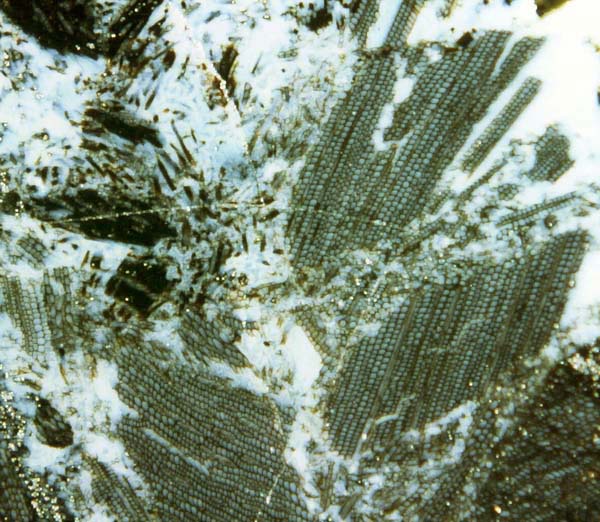
Fig.1: Lower Permian wood fragments in white chalcedony, Döhlen basin,
Germany.
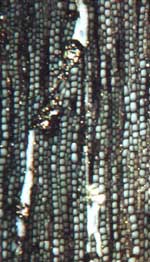
Fig.2: Same sample,
shear cracks with cell files partially rolled up (see idealized
drawing) and squeezed while soft.

The aspect had suggested the idea of brittle charcoal broken into
angular
fragments and dust-like debris. (M. Barthel,
private communication 1993).
Doubts arose from the observation that some
cracks in
the angular fragments look as if the wood was soft when they were
formed. The suspicion was confirmed by the complex
deformation phenomenon seen in the upper half of Fig.2: Two
cracks (above and left), whose planes are separated by 10 files of wood
cells, had been propagating between files, driven by overall shear
stress (Mode II cracks in terms of fracture mechanics) until their
overlapping stress fields offered another option: connecting their
crack tips by a strip of sheared but not broken wood. As a peculiar
fact, the overall shear displacement in the strip is realized by a
combination of local slip and winding of cell files into coils.
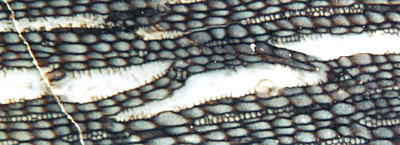
Fig.3: Same sample, gap bridged
with bent but not broken cell
files.
The
tiny remains of pith ray cell walls protruding into the cavities in
Fig.3 indicate that fracture started in the pith rays while the main
part of the wood was still coherent. A succession of broken pith rays
can appear and mechanically behave as a big crack bridged by bent cell
files, as also seen here.
It
would be hard to imagine that delicate structures like the sheared
strip connecting two cracks (Fig.2) or the bent cell files bridging the
gap (Fig.3) could have persisted through a forest fire without
breaking. As the coils
and bent files are virtually never found in a broken state, one can
safely assume that what is seen here is no charcoal but simply
wood slowly deformed and torn asunder after it had lost most of its
strength by lying in water and soft silica gel for some time. As a
result of such evidence, other images of this specimen have not been
offered as charcoal in [1], Fig.9, and in [7], Fig.199.
Fossil
charcoal has become a favourite interpretation always offered by some
palaeobotanists when fossil wood looks black and fragmented (Fig.4),
even if it comes in apparently enigmatic arrays as in Fig.5.
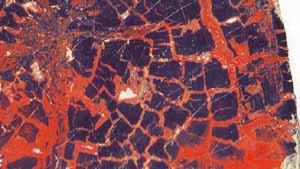
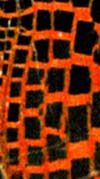
Fig.4:
Cross-section of Permian tree trunk allegedly turned into charcoal
without disintegrating into a pile of fragments before silicification.
Winnweiler,
Rhine-Palatinate, Germany. Detail from [2], Bild 449, width of the
picture 14cm.
Fig.5 (right): Permian tree trunk lengthwise
section, Winnweiler, Rhine-Palatinate, Germany. Detail from [3], Abb.6,
there interpreted as fossil charcoal blocks but recognized as
problematic. Height of the picture 1.3cm.
Apparently the authors [2,4] thought it possible that a tree trunk
turns into charcoal throughout although every
charburner knows that without intricate process control it would end up
in ashes.
The authors [3] saw the problems arising with Fig.5 and
tried to overcome them with the assumption that the silica gel split
the charcoal into blocks and subsequently separated the blocks from
each other. However, there are virtually no other cases known where
silica gel effected disintegration.
The authors [3] saw more problems with turning massive trunks into
charcoal. So they invoked the idea of a catastrophic event which piled
the trunks into big heaps so as to resemble a charcoal kiln if
incinerated. However, this would not work for lack of process control.
They did not see the simple solution: Their problems vanish with the
assumption that there is no charcoal involved. The observations suggest
a quite different explanation:
Apparently the wood substance underwent some slow process of
degradation while submerged in water containing silica, possibly
mediated by microbes, which brought about a
black aspect, reduced strength, and shrinkage with fragmentation.
According to the anisotropy of the wood strength, the pattern formation
in Fig.5 began with vertical through-cracks. The gaps between the
vertical wooden strips or rods became filled with silica gel which
stuck to the wood and whose strength was sufficiently high to prevent
lengthwise contraction of the rods as a whole. Hence, shrinkage stress
built up until the rod broke somewhere. As shrinkage continued, the
broken parts broke again until the fragments were so short that the
shrinkage stress did no more exceed the fracture strength. With simple
reasoning, such scenario leads to the conclusion that wider rods should
produce longer fragments, which is indeed realized in Fig.5. All
cracks and the wood fragments became filled with silica gel and finally
turned into chalzedony by uptake of more SiO2
and expulsion of water.
Similar wood decay into rectangular pieces, less
regular in
the absence of silica gel, is known as brown cubicle rot.
The interpretation as fossil charcoal had been
refuted by means of the
above arguments [5]. Nevertheless it is stubbornly being upheld at the
Museum für Naturkunde Chemnitz, despite of plain contrary evidence.
Figs. 1-3: sample W/55, own collection, found in 1992 at
Wilmsdorf golf course, Possendorf near Dresden, Photographs: M. Barthel.
Addendum 2015:
They
have got it at long last !
It took the authors [1-4] about ten years to absorb
the idea that they were wrong with their charcoal interpretation, and
they offer this as a new insight now [6]. They
could have arrived at this change of mind earlier if they had heeded my
repeated advice [5] from 2005 on. This gives reason for hope that
relentless
criticism over a long time will produce favourable results also in
other cases where authors, particularly R. Rössler
and
R. Noll, shy
away from discussions on their
publications.
Addendum 2017:
Palaeobotanists,
of course, would like to find fossil charcoal as probable evidence of
past wildfires whose frequency and extension would
allow conclusions to be drawn concerning the climate of bygone times.
The
notorious difficulty to distinguish between charcoal, which often comes
in small crumbs only, and black fossil wood requires particularly
careful examination of anatomical details of the cell structure,
preferably with the Scanning Electron Microscope [8].
H.-J. Weiss 2011, 2015,
2017
[1] M.
Barthel : Pflanzenfossilen im rechten
Licht. Veröff. Mus. Naturkunde Chemnitz 19(1996), 49-62.
[2] R.
Rössler: Der versteinerte Wald von Chemnitz. Museum
f. Naturkunde Chemnitz, 2001, 179.
[3] R.
Noll, D. Uhl, S. Lausberg : Brandstrukturen an
Kieselhölzern der Donnersberg Formation.
Veröff. Mus. Naturkunde Chemnitz 26
(2003), 63-72.
[4] R.
Noll, V. Wilde : Conifers from the „Uplands“
– Petrified wood from Central Germany,
in: U. Dernbach, W.D. Tidwell :
Secrets
of Petrified Plants, D'ORO Publ., 2002, 88-103
[5] H.-J.
Weiss : Seltsame Strukturen in Siliziten (Strange
structures in silicites), oral
presentation, 4th
Chert Workshop (2005),
Museum f.
Naturkunde
Chemnitz.
[6] R.
Rössler, R. Noll, D. Dietrich, V. Annacker, M. Merbitz:
Taphonomic features of fossilised wood ...
23rd Int. Workshop on Plant Taphonomy,
Museum f. Naturkunde Berlin, 11/2014.
[7] M. Barthel : Die
Rotliegendflora der Döhlen-Formation.
Geologica Saxonica 61(2015), 105-238. (Voricht, falsche
Größen !)
[8] A.Jasper,
D.
Uhl et al.: Evidence of wildfires in the Late Permian …, Current
Science 110 No3 Feb.2016, 419-423.
|

|
 9 9 |

 9
9






 9
9